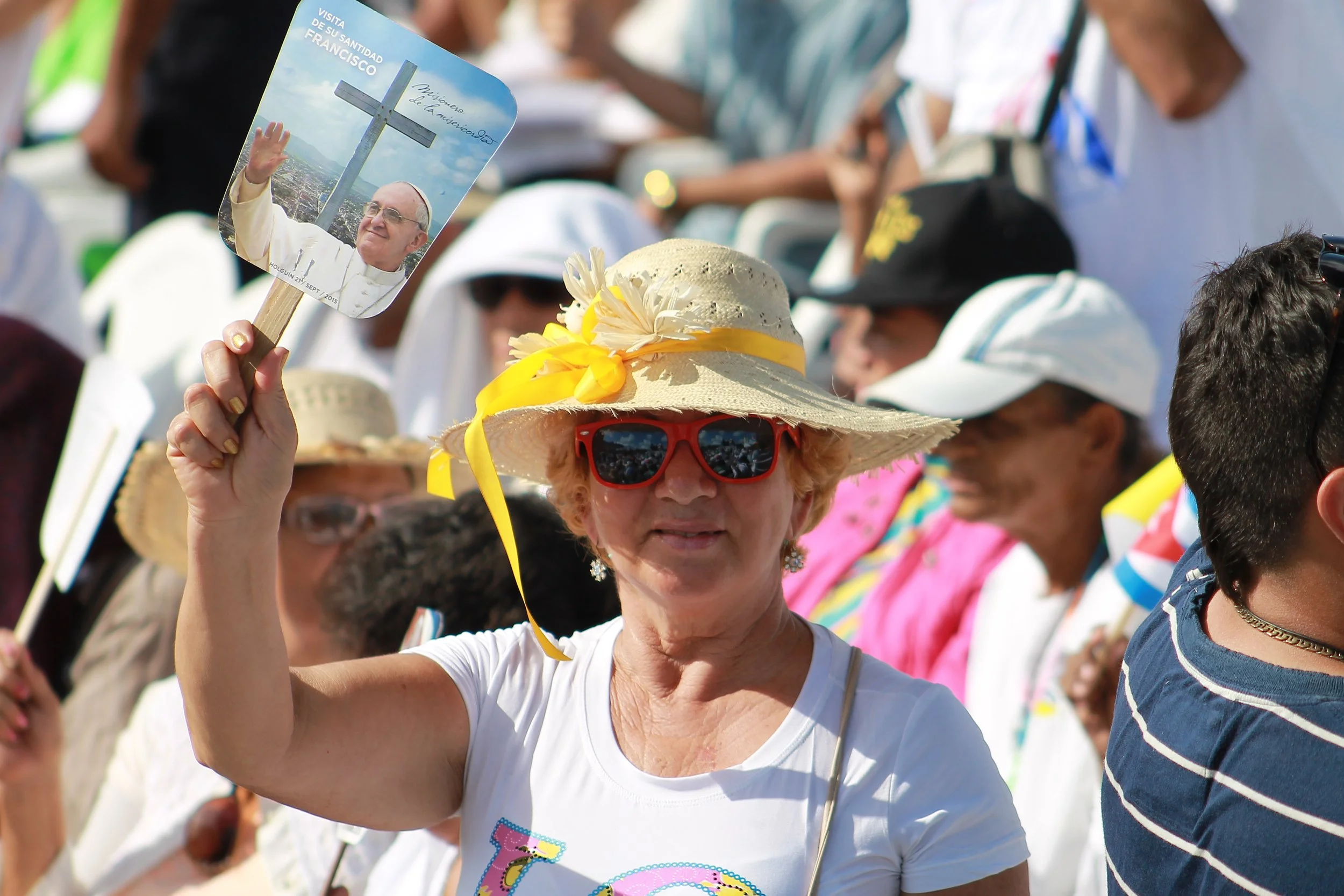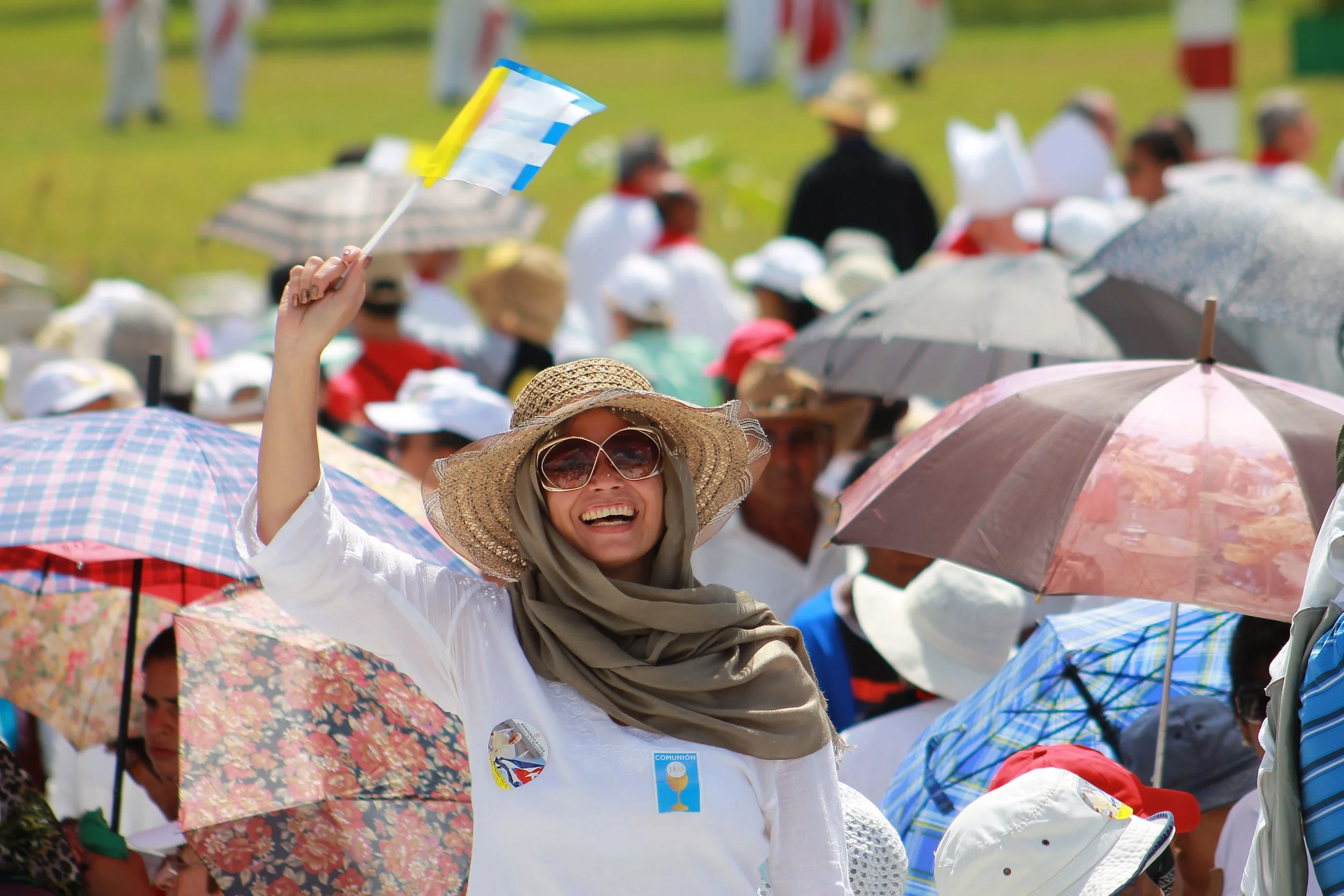Photographing the Pope
It was September 2015 when I was assigned to photograph the mass of Pope Francis, to be held in Holguín, Cuba. I was still working for the local newspaper ¡AHORA! and the excitement was enormous. The chance of covering a high-profile person, other than the occasional musician who traveled to the city every now and then, had never been presented to me.
With all the excitement, it was only natural that the news were shared among my many friends and acquaintances overseas. I had a solid background of support among many people in the United States and Canada, and it was almost an automatic decision to share the moment of success with them.
One of the people I shared my glory with was my good friend Kathy Willens, a seasoned AP photographer whom I had met three years before, and who had been examining my work, and giving me pointers on how to do better. Her advice will remain in my mind forever: she told me that as there were going to be other photographers with better equipment and better location than me, I should take photos of the Bishop of Rome, yes, but also focus on my people, the faithful in attendance.
I would not know what that meant. At least not immediately.
The important day came, and the Plaza de la Revolución Mayor General Calixto García was packed with people. Believers and non-believers flooded the place in a way that surpassed the largest crowd I had personally seen, which was when I witnessed a Fidel Castro speech in person.
Even with a cropped sensor Canon EOS Rebel T3 and a 75-300mm lens (which matches a 480mm reach in full-frame cameras), the distance between me and Pope Francis was going to be particularly long. My friend Kathy was more than right: other photographers were going to have a better location than me, and I had seen their gear, which was substantially better as well.
With that in mind, I turned my back on the “action” and started looking at the other protagonists. One thing I had learned about baseball is that the spectators are as important to the show as those performing it. The reactions and interactions make up for a great deal of the spectacularity we normally see in sports venues and music shows.
I was moved to an isolated tower that provided a better vantage point along with another Cuban photographer. He was from Havana and I was a local. Yet, even on that spot I realized that my situation (or my possibilities) had made just a slight improvement. The lens I was using, long as it was, did not provide a very sharp result at the full zoom range, and, on top of it all, Pope Francis was going to be in the shade while I was going to be in the sun, with some of the glare coming against me and no lens hood. So I was certain that I was not going to be able to render any meaningful images during the mass.
The Pope finally arrived, and people started cheering. I knew for a fact that I was going to have just slight windows to take good photos of him, and those windows were going to take place only before the mass. The podium was too far for me to take really sharp photos of him.
I managed a couple of good photographs of him waving at the holguineros. And one that I did not initially submit because of the craziness of the moment. The mass started and after a few minutes, I descended the tower to hide under my shirt (I was smart enough to wear two, so I could actually remove one and cover the computer screen from the glare of the sun) and download some of the photos, which I would later submit to the newsroom. It was my first time actually transmitting during a live event.
Pope Francis blesses a child prior to the mass he held in the Cuban city of Holguín on September 21, 2015. Although this is my favorite photo among the ones I managed to take of him, the glare on the computer screen kept me from submitting it for consideration to the newsroom. I would find this one as I went through the photos with my family at home, and the Special Edition of the newspaper for his visit had already been filed for printing.|Credit: Reynaldo Cruz Diaz
I submitted some photos of the Pope and the people, and put on my shirt. When I got out of my ostrich-like shelter, there was a security guy next to me, black slacks and guayabera, watching my every move. It felt silly for him to do that: I had gone through a thorough inspection, in which my gear had been x-rayed and sniffed for explosives or anything hazardous. Yet, the presence of then Cuban president Raúl Castro a few meters ahead of me made them even more paranoid than they normally were. If I (or anybody else for that matter) had been stupid enough to try anything, it would have been the last thing we did.
I climbed the ladder to the top of the tower again. The other photographer winked at me, and looked at the security guy like saying “These people will never change.”
The mass continued without too much else left. Despite the previous persecution and ostracism catholics were subject to in the first three decades (and well into the fourth) of the Revolution, there was a sense of complacence (we can’t be sure how honest, though) now with the Catholic Church. The last three sitting Popes had come to Cuba on official visits.






Just as the mass ended, people started disbanding. Pope Francis disappeared into the “safety” (1) of the offices beneath the podium at the square to change from his red garments back into his white ones.
Raúl Gullermo Rodríguez Castro, aka “El Cangrejo” (Spanish for crab) watches his grandfather Raúl Castro’s safety shortly before the mass of Pope Francis in Holguín.|Credit: Reynaldo Cruz Diaz
Due to our proximity to Raúl Castro and his whole entourage (which included his paranoid grandson, “El Cangrejo” or “The Crab”), me and my companion were instructed to stay atop the tower. For some reason, I had the feeling that my “moment” with the security man after I submitted the photos might have labeled us as “suspects” even though we both had gone through a security screening that went beyond paranoid.
While the other photographer was wrapping it up and ready to go (he had put all his gear away), I was looking into a situation in which I could have gotten my “hands” on a big pic. Again, he was seasoned, he had been overseas (I had never left the country at the time), and he might have probably been in John Paul II’s, or Benedict XVI’s masses, or maybe even both. He had captured what he wanted, but I hadn’t. I was still thinking of my friend Kathy Willens and her advice, and I was seeing that there were people who had decided to remain there to give “Francisco” (that’s how we knew him in Cuba) their last farewell… there was little to zero chance he would ever be back.
What very few people who have been to Cuba know is that there are really very few chilly days in the country, and that sometimes they only limit to December, January and February… and not even those three months. We can actually have bad heat in all three of them too.
So, September is not precisely friendly when it comes to temperatures.
While we both struggled to keep the sweat off our eyes—him to see when he could finally get off the calvary we were both in and me to see if I could finally get the shot that I thought I hadn’t been able to capture—, we saw the square getting clearer, but the guayabera and black pants guy was still there… at that moment, I looked at the two large booths. There was NOBODY there but us… and the Vatican Press.
For some reason… ¡Wait! There is a reason: Raúl Castro was no longer there. One thing you learn about working the Seguridad Personal (Secret Service equivalent) is that once the “leaders of the Revolution” were gone, there was no more protecting to do. At least not the one they would be afraid of. So, the people had gotten dispersed, and the paranoia had barely vanished.
That’s when I saw her. Wearing the fluorescent green shirts given to all people involved in the mass as a support staff, a young Cuban woman started walking towards the opening in the square where the Bishop of Rome was supposed to be coming out of. I had not put my camera away, and the old 75-300mm lens was on, in full zoom. My left eye, through the viewfinder, kept locked on her, like a sniper.
Then he came out: elegant and gracious, and she simply moved past his Swiss Guards and gave him a hug. He received it with a smile and she then held and kissed his hand before being gently pushed away by the smiling bodyguards. Throughout the two seconds that it all lasted, I kept on shooting, trying to capture a scene worth a story to tell.



The Pontiff got into his vehicle and they drove away slowly.
In my mind, it was all “mission accomplished”, but none of my favorite pictures would be published in the paper. Even though I submitted all of my work to them (some 500 images), the reality is that the photographs I had sent on the first wave were more than good enough for what the editors were looking for. They ultimately used them in a single page photo series of people’s reactions to the Pope. Definitely, my friend Kathy’s advice had helped me shoot the best editorial pictures. However, I wonder what would have happened if I had sent the ones that I consider my favorite in separate folders. Maybe they would have taken a closer look at them, but I will never know.
For being the first time transmitting live—and the first time transmitting someone of such importance—, I think my work was not horrendous. Yet, I can’t help admitting that my editorial skills (in terms of selecting and even editing some of the photos) could have been better.
There was still a lot to learn, at least in my point of view. I had been only five years doing photojournalism, and I had never been selected for anything of high importance until that day. Very few other opportunities would arise, at least with ¡AHORA!, but that was without question a learning experience.
I was just happy to have been a mere witness and documentarian of a moment in history… and even happier to have produced images that some people would appreciate later.



